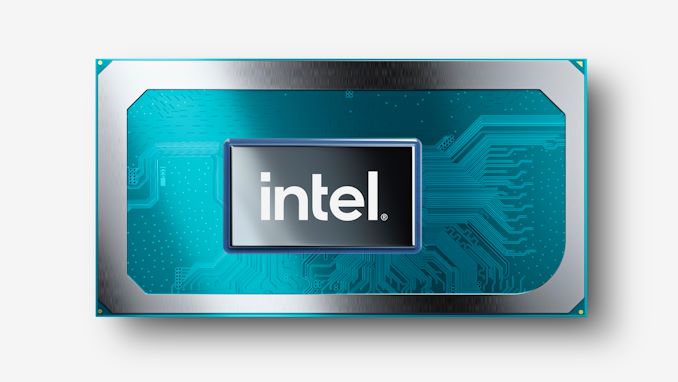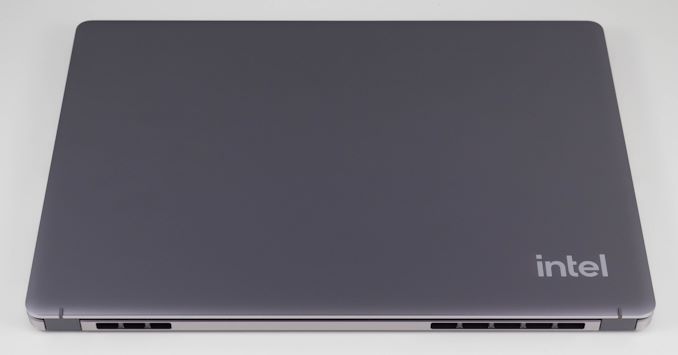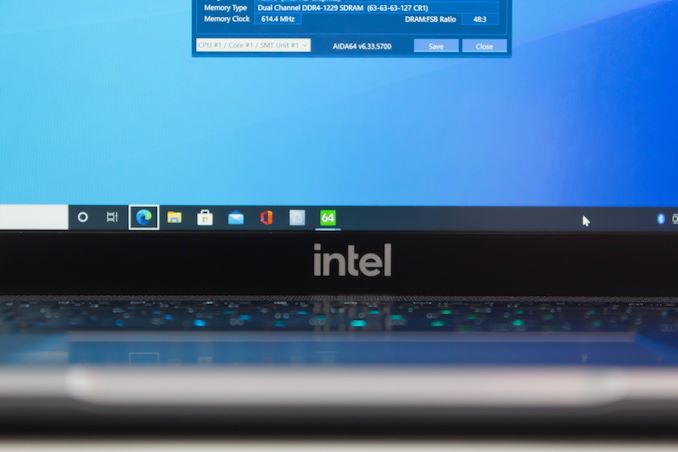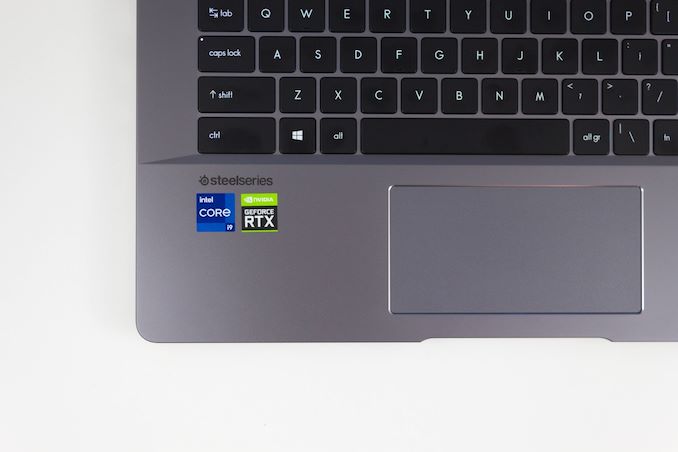Intel 11th Generation Core Tiger Lake-H Performance Review: Fast and Power Hungry
by Brett Howse & Andrei Frumusanu on May 17, 2021 9:00 AM EST- Posted in
- CPUs
- Intel
- 10nm
- Willow Cove
- SuperFin
- 11th Gen
- Tiger Lake-H

Last week Intel launched their Tiger Lake-H family of laptop processors. Aimed at the larger 14-inch and above laptops, this processor family is Intel’s newest offering for the high-performance laptop market, stepping in above Intel’s mobility-focused U and Y series of chips. Based on the same Tiger Lake architecture that we first became familiar with last year, Tiger Lake-H is bigger and better (at least where the CPU is concerned), offering up to 8 CPU cores and other benefits like additional PCIe lanes. Overall, Intel’s H-series chips have long served as the performance backbone of their laptop efforts, and with Tiger Lake-H they are looking to continue that tradition.
While last week was Tiger Lake-H’s official launch, as has become increasingly common for laptop launches, the embargoes for the launch information and for hardware reviews have landed on separate dates. So, while we were able to take about the platform last week, it’s only today that we’re able to share with you our data on TGL-H – and our evaluation on whether it lives up to Intel’s claims as well as how it stacks up to the competition.
Like Intel’s other laptop chips, Tiger Lake-H has multiple facets, with the company needing to balance CPU performance, GPU performance, and power consumption, all while ensuring it’s suitable to manufacture on Intel’s revised 10nm “SuperFin” process. Balancing all of these elements is a challenge in and of itself, never mind the fact that arch-rival AMD is looking to compete with their own Zen 3 architecture-based Ryzen 5000 Mobile (Cezanne) APUs.
| Intel Tiger Lake-H Consumer | ||||||||||
| AnandTech | Cores Threads |
35W Base |
45W Base |
65W Base |
2C Turbo |
4C Turbo |
nT Turbo |
L3 Cache |
Xe GPU |
Xe MHz |
| i9-11980HK | 8C/16T | - | 2.6 | 3.3 | 5.0* | 4.9 | 4.5 | 24 MB | 32 | 1450 |
| i9-11900H | 8C/16T | 2.1 | 2.5 | - | 4.9* | 4.8 | 4.4 | 24 MB | 32 | 1450 |
| i7-11800H | 8C/16T | 1.9 | 2.3 | - | 4.6 | 4.5 | 4.2 | 24 MB | 32 | 1450 |
| i5-11400H | 6C/12T | 2.2 | 2.7 | - | 4.5 | 4.3 | 4.1 | 12 MB | 16 | 1450 |
| i5-11260H | 6C/12T | 2.1 | 2.6 | - | 4.4 | 4.2 | 4.0 | 12 MB | 16 | 1400 |
| *Turbo Boost Max 3.0 | ||||||||||
Intel’s Reference Design Laptop: Core i9-11980HK Inside
For our Tiger Lake-H performance review, Intel has once again sent over one of their reference design laptops. As with the Tiger Lake-U launch last year, these reference design laptops are not retail laptops in and of themselves, but more of an advanced engineering sample designed to demonstrate the performance of the underlying hardware. In this specific case, the BIOS identifies that the laptop was assembled by MSI.
Wanting to put their best foot forward in terms of laptop performance, Intel’s TGL-H reference design laptop is, as you’d imagine, a rather high-end system. The 16-inch laptop is based around Intel’s best TGL-H part, the Core i9-11980HK, which offers 8 Willow Cove architecture CPU cores with SMT, for a total of 16 threads. This processor can turbo as high as 5.0GHz on its favored cores, a bit behind Intel’s previous-generation Comet Lake-H CPUs, but keeping clockspeeds close while making up the difference on IPC.
Unfortunately, their desire to put their best foot forward means that Intel has configured the CPU in this system to run at 65W, rather than the more typical 45W TDP of most high-end laptops. 65W is a valid mode for this chip, so strictly speaking Intel isn’t juicing the chip, but the bulk of the Tiger Lake-H lineup is intended to run at a more lap-friendly 45W. This gives the Intel system an innate advantage in terms of performance, since it has more TDP headroom to play with.
| Intel Reference Design: Tiger Lake-H | |
| CPU | Intel Core i9-11980HK 8 Cores, 16 Threads 2600 MHz Base (45W) 3300 MHz Base (65W) 5000 MHz Turbo 2C 4500 MHz Turbo nT |
| GPU | Integrated: Xe-LP Graphics 32 Execution Units, up to 1450 MHz Discrete: NVIDIA GeForce RTX 3060 Laptop 30 SMs, up to 1703MHz |
| DRAM | 32 GB DDR4-3200 CL22 |
| Storage | 2x OEM Phison E16 512GB SSD (NVMe PCIe 4.0 x4) |
| Display | 16-inch 2560x1600 |
| IO | 2x USB-C 2x USB-A |
| Wi-Fi | Intel AX210 Wi-Fi 6E + BT5.2 Adapter |
| Power Mode | 65 W (Mostly tested at 45W) |
Meanwhile the focus on CPU performance with TGL-H does come at a cost to integrated GPU performance. TGL-H parts include Intel’s Xe-LP GPU, but with only 32 EUs instead of the 96 found on high-end Tiger Lake-U systems. With TGL-H, Intel is expecting these systems to be bundled with discrete GPUs, so they don’t dedicate nearly as much die space to an integrated GPU that may not get used much anyhow. To that end, the reference system comes with an NVIDIA GeForce RTX 3060 Laptop graphics adapter as well, which is paired with its own 6GB of GDDR6.
Rounding out the package, the system comes with 32GB of DDR4-3200 installed. Storage is provided by a pair of Phison E16-based OEM drives, allowing Intel to show off the benefits of PCIe 4.0 connectivity for SSDs. Finally, Wi-Fi connectivity is also Intel-powered, using the company’s new AX210 adapter, which offers Wi-Fi 6E + BT5.2 on a single M.2 adapter. It’s worth noting that the AX210 is a fully discrete adapter, so it doesn’t leverage TGL-H’s integrated (CNVi) MAC, as that doesn’t support Wi-Fi 6E.
And, in keeping with making this reference system look as close to a retail design as reasonably possible, Intel even put the usual Intel Core and NVIDIA GeForce stickers on the laptop.
Unfortunately, we’ve had relatively little time with the system ahead of today’s embargo. The embargo on performance figures was originally scheduled for last Thursday (May 13th). However due to delays in shipping these laptops to reviewers, we didn’t receive the system until the end of last week, and Intel bumped back the embargo accordingly. So with just over two days to look over the system, we’ve really only had a chance to take a look at the most critical aspects of the system when it comes to performance.














229 Comments
View All Comments
eastcoast_pete - Monday, May 17, 2021 - link
A key question is now if Intel can further improve its 10 nm superfin process in time for Alder Lake. This TL is at least getting somewhat close to AMD's monolithic Zen3, but Rembrandt is around the corner, and that'll be an even more capable competitor. Right now, Intel retains its market share mostly because AMD can't deliver as many CPUs as people would buy.hfm - Monday, May 17, 2021 - link
I'm looking forward to an i5 or i7 design with no dGPU and that sweet embedded TB4. Probably going to be a small subset of the offerings like the lower tier XPS 15/17. Interested to see what comes about later in summer.evilspoons - Monday, May 17, 2021 - link
It'd be helpful to see power-normalized graphs, some of these results are a bit of a double-edged sword.outsideloop - Monday, May 17, 2021 - link
I want to see a comparison of the 11980HK with the 5800X clocked down to 65W, apples to apples. Let's compare the thermals of the AMD 8-core desktop to this "desktop replacement" Intel 8-core.Hifihedgehog - Monday, May 17, 2021 - link
Core i9-11980HK:https://images.anandtech.com/doci/16680/P95-45W_57...
Ryzen 9 5980HK:
https://images.anandtech.com/doci/16446/Power-P95-...
Just to add some further insight on these two charts, here is some breakdown. What ultimately happens is under sustained heavy loads, Ryzen 5000 series can maintain 8 cores at higher sustained clock speeds (~3.7 GHz) with lower power draw (35W). Bear in mind also that Zen 3 has a slight IPC advantage over Tiger Lake, meaning at a lower clock speed, it performs the same or does the same amount of work as Tiger Lake at a higher clock speed. Yet here we are where Ryzen 5000 can clock higher, do even MORE work, and draw less power. Meanwhile, Intel is struggling to reach similar sustained clock speeds (~3.2 GHz) at 45W sustained and it has slightly lower IPC. That is, Ryzen 5000 is ~10% faster clock-for-clock (or in IPC) than Intel's Willow Cove (Tiger Lake 11th Gen), Cypress Cove (Rocket Lake 11th Gen) or Sunny Cove (Ice Lake 10th Gen) which all three share roughly the same IPC amongst the whole trio (link: https://www.guru3d.com/articles_pages/intel_core_i... ). Ryzen 5000's synergy (higher clocks, lower power, higher IPC) sounds like a recipe for disaster for Intel, no? Alder Lake needs to come sooner rather than later if you ask me. Let's just hope Intel is throwing the full weight of their massive workforce of software developers at the problem of Alder Lake's heterogenous architecture because they will certainly need it working smoothly for it to shine.
lmcd - Monday, May 17, 2021 - link
Can we pause to note that MSI delivering bad thermal performance is characteristic of every single one of their laptops, bar none?lmcd - Monday, May 17, 2021 - link
Like, obviously that doesn't solve all the problems here, but how on earth with all the delays TGL-H(45+) got is this the OEM Intel picked?Spunjji - Tuesday, May 18, 2021 - link
It's a very odd choice. But then, didn't they use MSI for the original TGL reference platform too? That one actually outperformed most shipping devices, although IIRC it did so by running the fans at 100% 🤷♂️lmcd - Tuesday, May 18, 2021 - link
I put it on twitter also but my opinion is that the Tiger Lake MSI design is actually about the cooling and size that MSI would use for an H series processor normally, such as the MSI Creator.This implies that the MSI's thermal overhead is pure luck on Intel's part in that MSI didn't have time to reduce the thermal performance accordingly.
Spunjji - Thursday, May 20, 2021 - link
That would make sense!